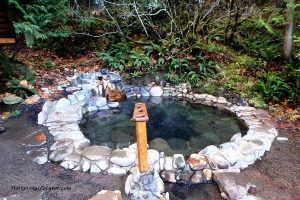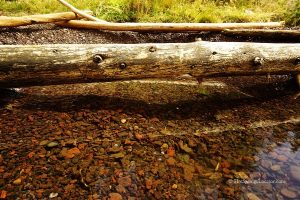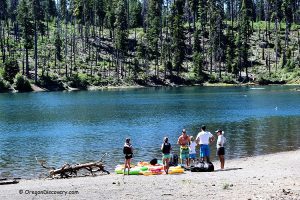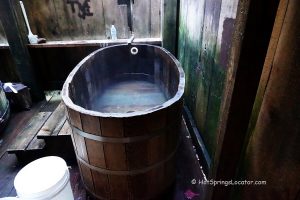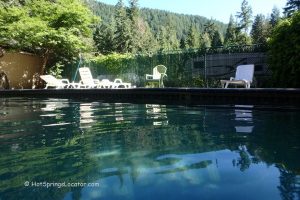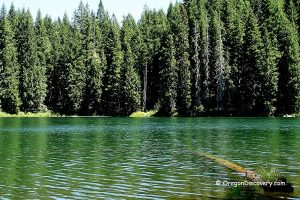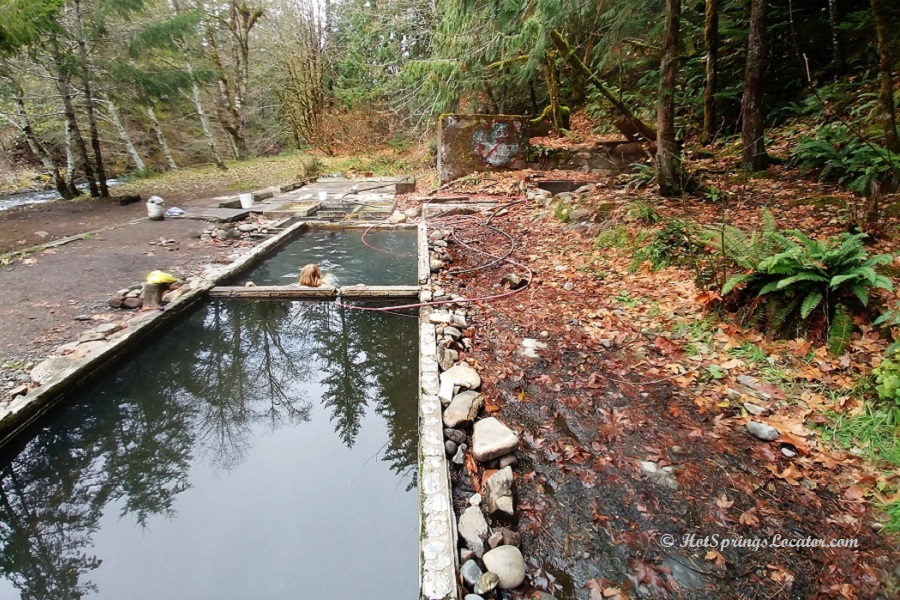
• Lower Breitenbush Hot Springs was a popular resort in the past
• There is a series of geothermal springs emerging along the Breitenbush River
Lower Breitenbush Hot Springs is located in the Willamette National Forest, about 600 feet away from the Breitenbush Hot Springs Retreat & Conference Center.
Once a well-known resort from 1910 to 1970, Lower Breitenbush Hot Springs is now abandoned, with only remnants of pools and buildings as reminders of its past. Today, two large swimming pools remain, along with the ruins of a concrete building and a few small concrete tubs.
Despite the lack of maintenance, Lower Breitenbush Hot Springs remains a popular destination. Several factors contribute to its appeal.
One is its scenic location along the river, surrounded by old-growth forest, and the other is its proximity to the Salem metropolitan area.

Another reason is that it is free and easy to access. If you suddenly feel like relaxing in hot mineral water, drive to Lower Breitenbush Hot Springs and enjoy a soak. In contrast, a visit to the nearby Breitenbush Hot Springs Retreat & Conference Center requires advance reservations.
Of course, there are also downsides to visiting Lower Breitenbush Hot Springs, which will be discussed shortly.
Lower Breitenbush is accessible via a 0.5-mile trail from the parking area. The trail leads to the river; once there, bear left and follow the river upstream to reach the hot springs. The path is fairly wide, making it difficult to get lost, and signs help guide visitors where the trail splits.
During low water levels, some visitors park on the opposite bank and cross the river on foot.
Caution. It is unsafe to ford the river during high water and spring runoff!

Lower Breitenbush consists of a series of geothermal springs emerging along the river at about 150°F. At the river's edge, there are two big concrete pools, a few small concrete tubs, and a few rusted bathtubs.
Water from the hot springs is transferred via hoses, and temperatures vary between the tubs and pools. If the water is too hot for, you can divert the hoses and wait until it cools down. Generally, the closer the tubs are to the source, the hotter the water.
Due to lack of maintenance, big pools look unsightly. The water is often unclear, and the slippery walls and floor indicate the presence of bacteria and algae. The smaller tubs are in better condition, as they are easier to clean before use.
Unfortunately, Lower Breitenbush has a serious litter problem. Please do not leave any trash behind—pack it out. If you have an extra bag, consider picking up any litter left by others.

Brief History of Lower Breitenbush Hot Springs
The river and hot springs were named after hunter Lewis Breitenbucher, who found and explored this area in the 1840s. By the late 19th century, the hot springs had become a popular destination known for the healing properties of their mineral-rich waters.
Until 1904, Lower and Upper Breitenbush were part of a single site. Following a property division, President Theodore Roosevelt granted Upper Breitenbush (now Breitenbush Hot Springs Retreat and Conference Center) to Claude Mansfield. Lower Breitenbush became federal land under the management of the USDA Forest Service. In the 1910s, the Forest Service leased Lower Breitenbush to Mark and Ada Skiff for the construction of a resort.
The resort quickly became popular among both locals and travelers. It featured three dozen cabins, a hotel, a restaurant, a store, a campground, a bathhouse with pools and a steam sauna, and even a small electric station. A footbridge was also built across the river.
However, severe flooding in the 1970s partially destroyed the infrastructure of both Breitenbush hot springs. The new owner of Lower Breitenbush Hot Springs could not rebuild the resort. As a result, the Forest Service revoked the lease, and Lower Breitenbush was never restored.
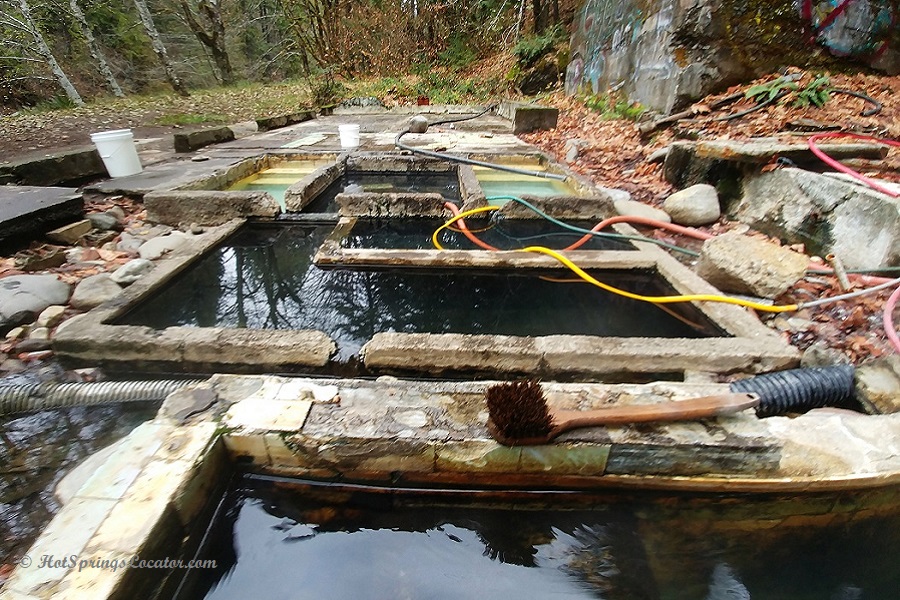
Lower Breitenbush Hot Springs Camping & Lodging
There are no posted restrictions on overnight camping in the area. However, you must stay at least 100 feet away from the hot springs. This site lacks amenities, so campers must be prepared to pack out all waste and follow Leave No Trace principles.
For those who prefer established campgrounds, Detroit Lake State Recreation Area, located about 12 miles west, offers campsites with restrooms, picnic areas, and lake access. The South Breitenbush Campground, a small forested site managed by the Forest Service, provides more secluded camping options closer to the hot springs.
For those seeking a more structured and serene experience, Breitenbush Hot Springs Retreat & Conference Center is just 600 feet away. This private, reservation-only retreat offers lodging in cozy cabins, vegetarian meals, and access to maintained hot spring pools.
For visitors who prefer a hotel or cabin stay, Detroit, Oregon, about 12 miles from Lower Breitenbush, has a few lodging options, including lakeside cabins and motels. These accommodations are ideal for those exploring the surrounding forest while staying near town amenities.
Salem, about 60 miles west, is the best option for a wider range of hotels, motels, and vacation rentals.
Video
Lower Breitenbush Hot Springs | Facts
Location: 10 miles northeast of Detroit • Oregon • USA
Open: Year-round
Development: Primitive
Clothing: Optional
Amenities: None
Hiking distance: 0.5 miles
Road access: Any vehicle, chains are required from November 1st to April 1st
Day-use: Free
Managed by: US Forest Service
Elevation: 2,160 ft (658 m)
Water T° (source): 150°F (65°C)
Water acidity level: Neutral (pH=7.3)
Springs Type: Sodium chloride
Average dissolved solids: 2,650 ppm
Chemical used: None
| Cations Sodium (Na) - 720 Mg/L Calcium (Ca) - 100 Mg/L Potassium (K) - 31 Mg/L Boron (B) - 4.1 Mg/L Lithium (Li) - 1.8 Mg/L Magnesium - 1.3 Mg/L | Anions Chloride (Cl) - 1,300 Mg/L Carbonate (CO3) - 144 Mg/L Sulfate (SO4) - 140 Mg/L Silica (SiO2) - 83 Mg/L Bromine (Br)- 5 Mg/L Flouride (F) - 3.4 Mg/L |
More Adventures
Directions to Lower Breitenbush Hot Springs
From the interstate Highway I-5,
- Take exit 253 in Salem for OR-22
- Go on OR-22 east for about 48 miles to Detroit
- Turn left onto Highway 46 (Breitenbush Road), and follow for about 9 miles to NF-2231
- Turn right, cross a single-lane bridge, then turn left
- Continue 1 mile on NF-890 to the parking and trailhead on your left.
Trailhead is located on the left side of the parking area.

